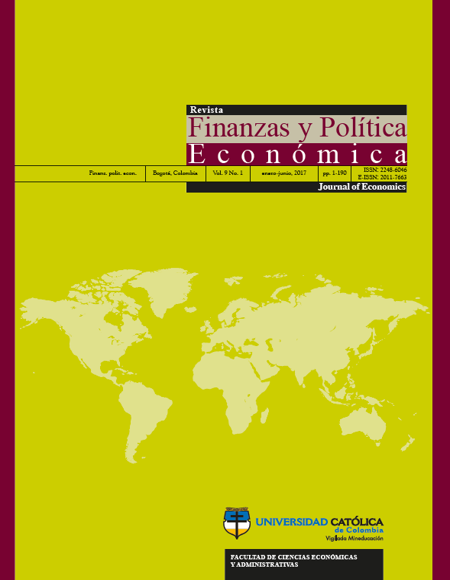
This work is licensed under a Creative Commons Attribution-NonCommercial-ShareAlike 4.0 International License.
This journal is licensed by a Creative Commons Attribution License (CC BY-NC-SA 4.0) Attribution-Non Commercial 4.0 International. For the CC licenses, the principle isthe creative freedom. This system complements the copyright without opposing it, conscious of its importance in our culture. The content of the articles is the responsibility of each author, and does not compromise in any way, to the journal or the university. It allows the transmission and reproduction of titles, abstracts and full content, with academic, scientific, cultural ends, provided acknowledgment of the respective source. This work cannot be used for commercial purposes.
They journal does not charge authors for submission or publication.
Abstract
This paper aims to analyze the beta convergence of Western Balkan countries towards the EU-15 Member States in the period 2004-2016, and two sub-periods: 2004-2008 and 2009-2013. Beta convergence is based on the neoclassical growth theory and tests the hypothesis that poor countries tend to grow faster than rich countries, in per capita terms. The empirical findings support the economic convergence hypothesis, with convergence rates ranging from 1.1% to 2.3%. The results show that the recent financial crisis negatively affected the absolute and conditional convergence process, when economic variables are included. The main limitation of the research is the availability of data.

References
Alcidi, C., Núñez Ferrer, J., Di Salvo, M., Pilati, M. & Musmeci, R. (2018). Income Convergence in the EU: A tale of two speeds. CEPS Commentary, 9 January 2018.
Barro, R. J. (1991). Economic Growth in a Cross Section of Countries. Quarterly Journal of Economics, 106(2), 407-443. https://doi.org/10.2307/2937943
Barro, R. J. & Sala-i-Martin, X. (1992). Convergence. Journal of Political Economy, 100(2), 223-251. https://doi.org/10.1086/261816
Benczes, I. & Szent-Ivanyi, B. (2015). The European economy in 2014: Fragile recovery and convergen- ce. JCMS: Journal of Common Market Studies, 53, 162-180. https://doi.org/10.1111/jcms.12266
Berend, I. T. (2016). An economic history of twentieth-century Europe: Economic regimes from laissez- faire to globalization. Cambridge University Press. https://doi.org/10.1017/CBO9781316479889
Bićanić, I., Deskar-Škrbić, M. & Zrnc, J. (2016). A Narrative Explanation of Breakpoints and Convergence Patterns in Yugoslavia and its Successor States 1952-2015. The wiiw Balkan Observatory Working Papers 122.
Borys, M. M., Polgár, È. K. & Zlate, A. (2008). Real convergence and the determinants of growth in EU candidate and potential candidate countries. A panel data approach. European Central Bank.
Botrić, V. (2013). Output Convergence between Western Balkans and EU-15. Research in Economics and Business: Central and Eastern Europe, 5(1), 46-62.
Chapsa, X., Tsanana, E. & Katrakilidis, C. (2015). Growth and Convergence in the EU-15: More Evidence from the Cohesion Countries. Procedia Economics and Finance, 33, 55-63. https://doi.org/10.1016/S2212-5671(15)01693-7
Colak, O. (2015). Convergence Revisited: Case of EU and Eastern Europe. Regional Science Inquiry, 7(1), 69-81.
El Ouardighi, J. & Somun-Kapetanovic, R. (2007). Do Balkan Countries Have a European Future? An Analysis of Real Economic Convergence, 1989-2005. South East European Journal of Economics and Business, 2(2), 23-30. https://doi.org/10.2478/v10033-007-0002-4
European Commission. (2015). Economic Reform Programmes of Albania, The Former Yugoslav Republic of Macedonia, Montenegro, Serbia, Turkey, Bosnia and Herzegovina and Kosovo: The Commission’s overview and Country assessments. Publications Office of the European Union, Luxembourg.
European Commission. (2018). Convergence Report. Institutional Paper 078. Publications Office of the European Union, Luxembourg.
Eurostat. (2018). Eurostat Database, https://www.ec.europa.eu/Eurostat
Grela, M., Majchrowska, A., Michałek, T., Mućk, J., Staźka-Gawrysiak, A., Tchorek, G. & Wagner, M. (2017). Is Central and Eastern Europe converging towards the EU-15? Narodowy Bank Polski, Education & Publishing Department.
International Monetary Fund. (2018). World Economic Outlook Database, https://www.imf.org
Jelnikar, E. & Murmayer, U. (2006). Convergence in Europe. Empirical Analysis on Two Groups of Countries of the European Union. Document presented at the International Conference on Human and Economic Resources, 246-260.
Joshi, B., Atoyan, R. & Roaf, M. J. (2014). Regional Economic Issues - Special Report 25 Years of Transition: Post-Communist Europe and the IMF. International Monetary Fund.
Matkowski, Z. & Próchniak, M. (2004). Economic convergence in the EU accession countries. Composite Indicators of Business Activity for Macroeconomic Analysis (‘The RIED Papers and Proceedings’, vol. 74), SGH, Warsaw, 405-425.
Micallef, B. (2017). The process of Economic Convergence in Malta and in the European Union. Central Bank of Malta Policy Note, Central Bank of Malta, Valletta. Retrieved from: https://www.centralbankmalta.org/file.aspx?f=51536
Oblath, G., Palocz, E., Popper, D. & Valentinyi, Á. (2015). Economic convergence and structural change in the new member states of the European Union. Center for Economic and Regional Studies, Hungarian Academy of Science.
Pipień, M. & Roszkowska, S. (2018). The heterogeneity of convergence in transition countries. Post- Communist Economies, 31(1), 1-31. https://doi.org/10.1080/14631377.2018.1443245
Podkaminer, L. (2013). Development Patterns of Central and East European Countries (in the course of transition and following EU accession). Vienna Institute for International Economic Studies.
Sala-i-Martin, X. (1994). Cross-sectional regressions and the empirics of economic growth. European Economic Review, 38(3-4), 739-747. https://doi.org/10.1016/0014-2921(94)90109-0
Siljak, D. & Nagy, S. G. (2018). The effects of the crisis on the convergence process of the Western Balkan countries towards the European Union. Society and Economy, 40(1), 105-124.
Solow, R. M. (1956). A Contribution to the Theory of Economic Growth. Quarterly Journal of Economics, 70, 65-94. https://doi.org/10.2307/1884513
Strielkowski, W. & Höschle, F. (2016). Evidence for economic convergence in the EU: The analysis of past EU enlargements. Technological and Economic Development of Economy, 22(4), 617-630. https://doi.org/10.3846/20294913.2014.890138
Tsanana, E., Katrakilidis, C. & Pantelidis, P. (2013). Balkan area and EU-15: An empirical investigation of income convergence. In Balkan and Eastern European Countries in the Midst of the Global Economic Crisis, Physica-Heidelberg, 23-33. https://doi.org/10.1007/978-3-7908-2873-3_2
Vojinović, B., Acharya, S. & Próchniak, M. (2009). Convergence analysis among the ten European tran- sition economies. Hitotsubashi Journal of Economics, 50(2), 123-141.
World Bank. (2018). World Development Indicators Database, https://www.databank.worldbank.org
Źuk, P., Polgar, E.K., Savelin, L., Diaz del Hoyo, J.L. & König, P. (2018). Real convergence in central, eastern and south-eastern Europe. ECB Economic Bulletin, Issue 3/2018





























